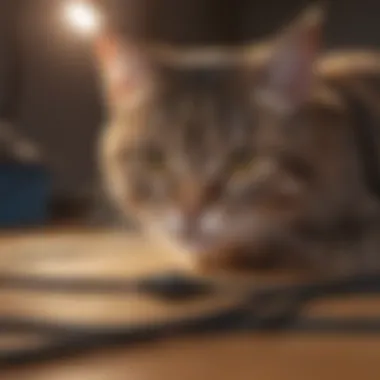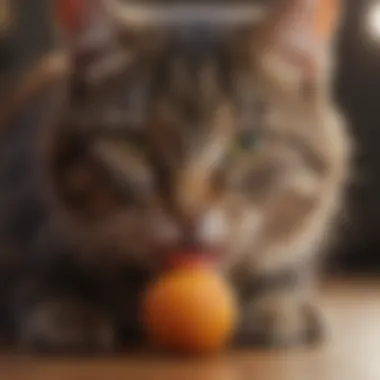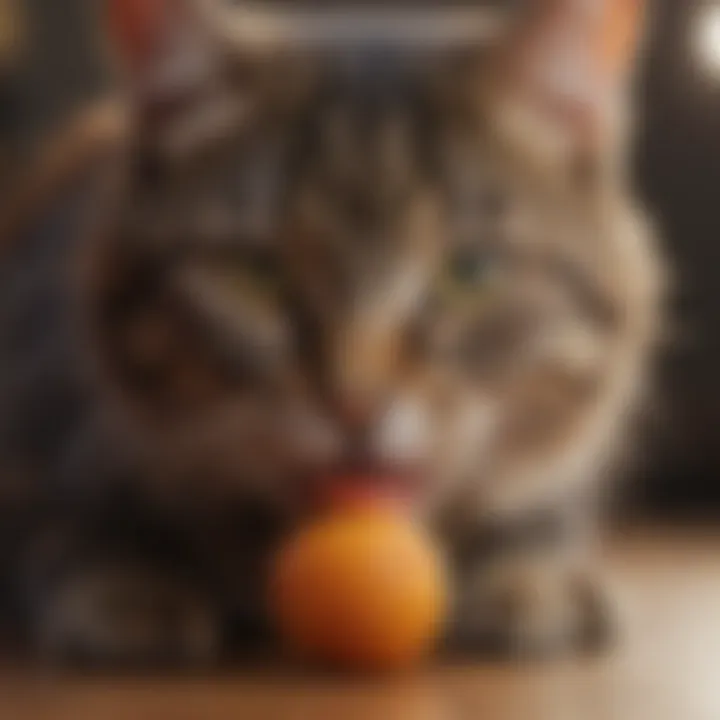Understanding Why Cats Chew on Cords: Insights & Solutions


Intro
Cats are known for their unique habits and behaviors, some of which can be puzzling to their owners. One behavior that often raises concerns is their inclination to chew on cords. This tendency is not merely a quirk; understanding the underlying reasons can help pet owners protect both their cords and their feline companions. This article will navigate through various aspects of cord chewing in cats, exploring instinctual behavior, environmental influences, and potential health issues. We will also discuss effective preventive measures and corrective actions to address this behavior.
Pet Care and Grooming
Understanding your cat's grooming and care needs is crucial for overall well-being. Regular care does not just contribute to physical health but can also impact behavioral patterns, including cord chewing. Cats are meticulous groomers, but sometimes they need additional support from their owners. This section highlights several important aspects of pet care.
Importance of Regular Care
Cats thrive on routine. Regular grooming helps in maintaining a healthy coat and reducing shedding, which can be a distraction for some cats. A well-groomed cat is less likely to engage in destructive behaviors such as chewing cords. Establishing a grooming routine will enhance the cat's comfort level and reduce stress.
Grooming Techniques by Pet Type
Different breeds have different grooming requirements. Long-haired cats require more frequent brushing to prevent matting, while short-haired cats may need brushing less often. Understand your cat's breed and its specific needs can help ensure effective grooming.
Tools and Products Recommendations
Invest in quality grooming tools. A good brush, nail clippers, and appropriate shampoo can make a significant difference. Some recommended products include:
- FURminator deShedding Tool
- PetFusion Ultimate Dog Grooming Kit
- Earthbath All Natural Pet Shampoo
Using the right tools contributes to a positive grooming experience.
Seasonal Care Tips
Seasonal changes can affect your cat's grooming needs. During shedding season, more frequent grooming may be essential. Ensure your cat’s grooming routine adapts to changes in climate, and protect their skin and coat from seasonal allergens and irritants.
Health and Nutrition
A healthy diet is pivotal in addressing behaviors like chewing cords. Nutritional deficits can manifest in unusual habits, including excessive chewing. Understanding your cat's dietary requirements can play an important role in preventing this behavior.
Understanding Pet Nutrition
Cats are obligate carnivores. Their diet should consist primarily of protein. Look for high-quality commercial cat food that meets these nutritional standards. Keeping your cat well-fed can reduce unwanted behaviors as they are satisfied and less likely to search for alternative chewing opportunities.
Common Health Issues by Species
Certain health issues may drive chewing behavior. For instance, dental problems can lead to increased chewing as a means of alleviating discomfort. Regular veterinary check-ups are essential for identifying and addressing potential issues that may lead to problematic habits.
Preventive Care and Regular Check-Ups
Regular veterinary visits can help spot issues early. Preventive care ensures that your cat remains healthy overall, which can reduce the likelihood of behavioral problems. A good wellness plan is important for long-term well-being.
Food and Dietary Advice
Choosing high-quality food and maintaining a proper feeding schedule can greatly influence behavior. Avoid sudden diet changes; they can result in stress for your cat. Consult with your veterinarian to develop an ideal dietary plan that avoids deficiencies.
Behavioral Training
Training your cat can significantly alter their chewing behavior. Implementing positive reinforcement methods can help guide your cat away from undesirable habits like cord chewing and promote healthier choices.
Basics of Positive Reinforcement
Positive reinforcement involves rewarding desired behaviors rather than punishing undesirable ones. When your cat engages in appropriate play or chewing on toys instead of cords, provide a reward. This encourages repetition of favorable actions.
Training Techniques Users Can Apply
Use interactive toys or treats as incentives to train your cat. When your cat chooses the toy over the cord, praise and reward them immediately. Consistency in training is key.
Managing Behavioral Issues
Identifying triggers is essential for managing unwanted cord chewing. If boredom or anxiety causes the behavior, addressing these underlying issues will help in correcting the problem. Consider providing engaging toys or adding more playtime.
Importance of Socialization
Cats benefit from social interaction, which can alleviate stress and anxiety. Ensure your cat engages with both humans and other pets in a safe manner. A well-socialized cat tends to be more balanced and less likely to develop destructive behaviors.
Engaging Activities and Enrichment
Encouraging your cat to engage in play and enrichment activities is crucial in preventing cord chewing. Boredom is a significant motivator for this behavior, so it is important to provide stimulating alternatives.
Fun Games to Play with Your Pet
Interactive play promotes bonding and can distract from undesirable behaviors. Simple games like chase, hide and seek, or using a feather toy can keep your cat entertained.
DIY Toys and Activities
Homemade toys can be an excellent alternative to expensive options. Using household items like cardboard boxes, paper towels, or even old socks filled with catnip can provide hours of entertainment.
Importance of Mental Stimulation


Cats are intelligent animals that require mental challenges. Puzzle feeders or treat-dispensing toys help stimulate their minds and keep them engaged.
Outdoor Adventures and Exploration
If safe, supervised outdoor experiences can greatly enrich a cat’s life. A leash can be used for training. This allows your cat to explore and satisfy their curiosity and reduce the urge to chew on cords indoors.
Resources and Community Engagement
There is a wealth of information available to cat owners. Engaging with communities can foster better understanding and practices that help manage behaviors like chewing.
Recommended Books and Websites
Various resources provide insights into feline behavior. Notable mentions include The Cat Behavior Answer Book and websites like en.wikipedia.org and britannica.com that offer general information on feline health and behavior.
Forums and Groups for Pet Owners
Online communities on platforms like reddit.com and facebook.com are valuable for connecting with other cat owners. These forums can provide support and share experiences and solutions.
Finding Local Services and Classes
In-person training services or local pet clubs can be beneficial for intensive training sessions. Look for classes that focus on feline behavior for tailored advice based on your cat's needs.
Encouraging Community Sharing and Contributions
Communities thrive on shared knowledge. Encouragement for contributions of personal experiences can lead to a richer pool of information for all cat owners. Consider sharing your own experiences with cord-chewing issues and solutions.
Understanding feline behavior is key to nurturing a harmonious relationship between cats and their owners. Through awareness, appropriate care and training can create an environment that keeps both cords and cats safe.
Prolusion to Cat Behavior
Understanding cat behavior is essential for every pet owner. The motivations behind specific actions shed light on a cat's well-being and its relationship with its environment. When cats engage in behaviors such as chewing on cords, it raises concerns not only about the pet itself but also about home safety.
Cats are unique creatures. Their instincts and personality play a significant role in how they interact with inanimate objects. Chewing, for instance, might stem from natural tendencies, much like scratching or climbing. This article focuses on why cats may gravitate toward cords, why addressing this behavior matters, and what it signifies about their mental state.
One major benefit of understanding these behaviors is prevention. Insight into why a cat chews on cords can motivate owners to take necessary measures, minimizing risks of injury or damage. The relationship between a pet and its owner can be deeply enriched when problems are approached with knowledge and empathy.
The importance of exploring cat behavior is multifaceted. It encompasses emotional health, environmental awareness, and proactive measures, making it a pivotal topic for anyone looking to improve their interaction with feline companions. This foundation connects the dots between instincts and the often perplexing actions of our cats. Moreover, a good grasp of these aspects can lead to a safer and more harmonious living environment for both pets and owners.
“Understanding the motivations behind feline behavior can lead to effective strategies and a more peaceful home.”
Understanding Feline Instincts
Understanding why cats chew on cords necessitates a closer look at their natural instincts. Feline behavior is deeply rooted in their ancestry, and recognizing these instincts can help owners manage this behavior. Cats are instinctual hunters and explorers. They use their teeth and paws to investigate their environment. Cord chewing can often originate from these natural tendencies. By understanding these motives, pet owners can implement preventive measures and create a safer environment for their cats.
Natural Chewing Behaviors
Chewing is a significant behavior observed in many cats. It serves various purposes, from exploration to maintaining dental health. Cats often chew on objects as a way to learn about their surroundings. Strings, cords, and other soft materials can be particularly enticing due to their texture and movement. This instinct often mirrors the way they would interact with prey in the wild.
Moreover, chewing can prevent dental issues. If a cat is provided with appropriate items to chew on, such as toys, it can help maintain their teeth. Recognizing that chewing behavior stems from instinct rather than disobedience is crucial for owners. By addressing this natural tendency, owners can redirect their cats toward safer alternatives, ensuring both health and safety.
Play and Exploration
Cats are naturally curious creatures. During play, they engage in various activities that simulate hunting behaviors. Chewing on cords may occur during playtime as they perceive these objects as prey. This behavior can become more pronounced in young felines. Kittens often explore their environment through play, which can lead to chewing behaviors.
To reduce cord chewing, it is essential to provide engaging toys that stimulate cats mentally and physically. Toys that mimic the movements of prey can capture their attention and decrease the likelihood of cords becoming targets. Owners should dedicate time to interactive play sessions to foster healthy exploration habits and minimize unwanted chewing.
In summary, recognizing natural behaviors in cats is foundational for understanding their inclination to chew on cords. By providing alternatives and understanding their instincts, owners can create a safe space for their feline companions.
Common Reasons for Chewing Cords
Understanding why cats chew on cords is essential for any pet owner. This knowledge helps you address the underlying issues that drive this behavior. Recognizing the motivations can lead to effective solutions and a safer home environment. If not understood, cord chewing can result in serious health risks for the cat, such as choking or electric shock.
Boredom and Lack of Stimulation
Boredom is a primary factor that can lead a cat to chew on cords. Cats are intelligent creatures that require mental and physical stimulation. Without it, they may seek out unconventional activities, such as gnawing on cords. This behavior can be seen as a form of self-entertaining, albeit a dangerous one.
To mitigate boredom, consider the following:
- Interactive toys: These can keep a cat engaged and mentally stimulated.
- Puzzle feeders: They can provide mental challenges while promoting healthy eating habits.
- Routine playtime: Regular interaction between the owner and cat allows for physical workout and bonding.
A well-stimulated cat is less likely to resort to risky behaviors like chewing cords. Finding ways to enrich your cat's environment is crucial.
Anxiety and Stress Responses
Anxiety can manifest in various ways in cats. If a cat feels stressed, it may chew on cords as a coping mechanism. Changes in the household, like new pets or loud noises, can trigger this behavior. Identifying stressors is important.
Some signs of anxiety in cats include:
- Excessive grooming
- Hiding or avoiding social interaction
- Changes in eating habits
To decrease stress:


- Create a routine for feeding and playtime.
- Provide safe spaces with cozy beds where they can retreat.
- Use calming products such as pheromone diffusers.
Understanding the sources of anxiety can help in creating an environment that is less likely to provoke destructive chewing habits.
Teething in Kittens
Kittens, like human children, go through a teething phase. During this time, they might chew more than usual. This behavior is instinctual as they seek relief from the discomfort associated with teething. Cords can easily become targets because they are appealing to chew on.
To support a teething kitten:
- Provide appropriate chew toys: These should be designed specifically for kittens, offering the right firmness and texture.
- Monitor their chewing: Redirect their attention to safe items when you see them chewing on cords.
- Use cold items: A cold, wet cloth can soothe sore gums, offering comfort.
By addressing teething properly, owners can help kittens avoid the risky behavior of chewing cords.
It's crucial to create a safe environment and employ preventive measures to protect cords while helping your feline friends.
Health Risks Associated with Chewing Cords
Understanding the health risks associated with cats chewing cords is essential for all cat owners. This behavior can lead to serious health implications for felines, necessitating a proactive approach to managing their environment. Cats are naturally curious and often explore by chewing. Unfortunately, this instinct can put them in danger when it involves electrical or other types of cords. Recognizing the potential hazards allows owners to implement safety measures, therefore, protecting their pets from harm.
Electric Shock Hazards
One of the gravest dangers cats face from chewing cords is electric shock. Many household appliances and devices are connected to power sources through cords that can be easily chewed. When a cat bites into a live wire, the potential for severe electric shock exists. The effects can vary but may include burns, cardiac arrest, or even death. The risk increases with the availability of several wires in households. Pet owners must stay vigilant and identify any frayed or exposed cords that could be prone to such incidents.
To mitigate these hazards, consider the following steps:
- Inspect cords regularly for wear and tear.
- Use cord covers or protectors designed to shield wires from chewing.
- Avoid overheating outlets with multiple devices.
Identifying At-Risk Cords and Wires
Understanding which cords and wires are at risk is a critical step in addressing the behavior of cats chewing on them. By recognizing these at-risk items, owners can take proactive measures to protect both their pets and the integrity of their homes. Chewing on cords does not simply lead to potential damage; it poses serious health risks to cats. Identifying these hazards is the first part of any effective prevention strategy.
Types of Cords Commonly Chewed
Some cords are more appealing to cats than others. These include:
- Electronics Cords: Cables for devices such as laptops, televisions, and chargers are common targets due to their accessibility and texture.
- Extension Cords: Often left out in the open, extension cords are easily within reach for curious cats.
- Phone Chargers: These tend to be lightweight and can also have appealing textures for chewing.
- Power Cords for Appliances: Cords attached to mixers, blenders, or other kitchen appliances may attract cats due to their placement.
Understanding which cords are commonly chewed allows owners to be more vigilant in securing these potential sources of danger.
Locations Prone to Chewing
Certain locations within a home are particularly prone to cord chewing. Notably:
- Near Electronics: Areas where devices such as computers, televisions, and gaming consoles are used are frequent spots for cats to play and chew.
- Under Furniture: Cords that run under sofas or beds often get overlooked but can be easy targets for cats seeking something to gnaw.
- Open and Accessible Spaces: Cords placed in open areas, especially those that dangle or are loosely placed, invite cats' curiosity.
- Kitchens: Appliances in kitchens often have cords that dangle and are left exposed, making them a tempting object for curious felines.
Understanding these locations can help pet owners minimize the risks of chewing by rearranging cords and devices to less accessible places or using protective coverings.
"Identifying cords that are at risk can save your cat from serious harm and prevent costly damage to your home."
Preventive Measures to Protect Cords
Preventing cats from chewing on cords is an essential concern for pet owners. It not only protects valuable electronics but also ensures the safety and well-being of the cat. Understanding preventive measures is the first step to reducing instances of cord chewing. These steps help create a safer environment that minimizes risks associated with cords and encourages healthier behaviors in felines. Each preventive approach offers distinct advantages, addressing both the physical safety of cords and the behavioral tendencies of cats.
Using Cord Covers and Protectors
Implementing cord covers and protectors is one of the most effective strategies to deter cats from chewing on cords. These covers act as barriers, making cords less accessible and less appealing to pets. Many pet stores offer a variety of options, such as flexible plastic tubing or specially designed wrapping sheets. Choosing a cover that fits snugly over the cord ensures maximum protection.
When selecting cord covers, consider the following:
- Material: Choose a durable material that can withstand chewing.
- Size: Ensure the cover fits the cord securely without being too loose.
- Aesthetics: Find options that complement your home decor to maintain visual appeal.
By using these protective measures, pet owners can safeguard cords from damage while keeping their pets safe from potential hazards.
Creating a Cat-Friendly Environment
Designing an environment that caters to the natural behaviors of cats may help reduce cord chewing. By ensuring that the cat has an engaging space, you can distract them from cords and wires. Cats thrive in environments that provide variety and stimulation. Here are some ways to enhance their surroundings:
- Interactive Toys: Provide a range of toys that promote active play.
- Climbing Structures: Use cat trees or shelves to encourage climbing and exploration.
- Safe Zones: Create areas where cats can retreat and feel secure.
This approach not only discourages chewing but also taps into a cat’s instinctual behaviors, promoting physical and mental health.
Regularly Engaging Play Sessions
Engaging in play is vital for a cat’s well-being and can significantly reduce unwanted behaviors, including cord chewing. Regular play sessions help expend energy and satisfy the cat’s curiosity. Interactive play with wand toys, laser pointers, or even simple fetch can redirect focus away from cords.
Incorporating play into your daily routine has several benefits:
- Physical Exercise: Helps keep your cat physically healthy.
- Bonding Time: Enhances your relationship through shared activities.
- Mental Stimulation: Challenges your cat’s mind and reduces boredom.
Consistency in play is key. Schedule short sessions throughout the day, as this fosters a routine that meets the cat’s needs. In summary, a multifaceted approach utilizing protective covers, a nurturing environment, and regular interactive play can effectively manage and reduce the tendency of cats to chew on cords.


Behavioral Modification Techniques
Positive Reinforcement Strategies
Positive reinforcement strategies are pivotal for shaping desired behaviors in cats. This method relies on rewarding a cat for appropriate actions rather than punishing them for unwanted ones. For example, when a cat plays with an approved toy instead of chewing on cords, providing a treat or praise can reinforce this behavior. Over time, the cat associates the behavior with positive outcomes, making them more likely to repeat it.
Key elements to consider include:
- Consistency: Always reward the desired behavior to establish a clear connection.
- Timing: Immediate rewards reinforce the action. Delaying rewards can confuse the cat.
- Variety: Use different rewards to keep the cat engaged, such as treats, toys, or affection.
Redirecting Attention to Toys
Redirecting attention to toys is another effective approach in curbing unwanted cord chewing. Cats naturally have a playful curiosity, and leveraging this trait can help shift their focus. Providing a variety of engaging toys can keep a cat entertained and less interested in cords. It is vital to choose toys that fulfill their instinctual needs for chasing, batting, and biting.
Consider including:
- Interactive Toys: These toys often engage a cat physically and mentally, maintaining their interest for longer periods.
- Puzzle Toys: Toys that involve problem-solving can stimulate a cat's mind, keeping them occupied.
- Catnip-Infused Toys: Many cats are attracted to catnip, which can make toys even more enticing.
By introducing these engaging alternatives, owners can help alleviate boredom and prevent cats from turning to cords out of sheer curiosity or lack of stimulation.
Using Deterring Sprays
Using deterring sprays is another method that can aid in modifying a cat's behavior. These sprays are designed to have unpleasant scents that repel cats from certain areas or objects, like cords. By applying these sprays to areas where cats tend to chew, owners can dissuade the behavior without causing harm. It is essential to select sprays that are safe for pets and non-toxic.
When using deterring sprays, keep in mind:
- Application: Apply the spray consistently on the cords but avoid getting it on your hands or your cat to prevent agitation.
- Reapplication: The effectiveness may diminish over time, so regular reapplication is recommended.
- Compatibility: Ensure your cat does not have allergies or sensitivities to any of the ingredients used in these sprays.
In many cases, combining techniques simultaneously yields the best results, creating a comprehensive approach to managing the behavior of cats in a constructive manner.
When to Seek Professional Help
Understanding when to seek professional help is crucial for any cat owner concerned about their pet's well-being. Cats may chew on cords due to various reasons, some of which might be easily correctable. However, when specific behaviors persist or intensify, and when they are linked to signs of anxiety, it may be time to consider consulting experts. This section will highlight the key indicators that should prompt you to seek assistance.
Signs of Severe Anxiety
Severe anxiety in cats can manifest in a range of behaviors, including excessive chewing on cords. Here are some signs that suggest a cat might be experiencing heightened anxiety:
- Persistent Scratching or Chewing: If chewing occurs frequently and aggressively.
- Changes in Behavior: Noticeable withdrawal or aggression towards people or other pets.
- Excessive Vocalization: Increased meowing or yowling might indicate distress.
- Altered Eating Habits: A sudden shift in appetite, whether increased or decreased.
- Litter Box Issues: Urinating or defecating outside the box often signals stress or anxiety.
Recognizing these signs can help cat owners determine when anxiety is severe enough to need professional help. Anxiety can significantly affect a cat’s quality of life, and timely intervention can make a large difference.
Consulting with a Veterinarian or Behaviorist
If negative behaviors, including chewing on cords, become frequent or are linked with signs of severe anxiety, consulting a veterinarian or a feline behaviorist is advised. These professionals can provide insights that are often beyond the pet owner's expertise. Here are some considerations for seeking help:
- Behavioral Assessment: Professionals can evaluate the cat's behavior in context, giving a clearer picture of the underlying issues.
- Health Evaluation: A veterinarian can rule out any medical conditions that may contribute to anxiety or harmful behaviors.
- Personalized Treatment Plans: Experts can design tailored plans to address the specific needs of the cat, which can include behavioral modification techniques, training strategies, and, if necessary, medication.
Seeking professional help not only addresses the immediate issues related to chewing on cords but also ensures long-term health and stability for the cat.
Consider prioritizing your pet's mental health as well as physical safety when evaluating their habits.
Taking action sooner rather than later can help maintain harmony in the home and contribute to the overall well-being of your feline companion.
Concluding Thoughts
Understanding why cats chew on cords is crucial for any pet owner. This behavior is more than just a quirky trait; it often stems from instincts, environmental factors, or health issues.
Recognizing the underlying motivations can help owners take proactive measures to prevent unsafe behaviors. Here are some key points to consider:
- Safety Risks: Chewing cords can lead to severe health risks for cats, including electric shock and choking hazards. Being aware of these dangers can motivate owners to take immediate action.
- Behavior Modification: Understanding that chewing can be redirected through positive reinforcement is essential. Establishing healthy habits can lead to better outcomes for both cats and owners.
- Creating a Safe Environment: By making adjustments in the home, such as using cord covers or creating stimulating play areas, owners foster a safer, more engaging environment for their pets.
Focusing on these aspects not only enhances the quality of life for cats but also eases the minds of their owners. A secure home minimizes risks and demonstrates the owner’s commitment to their pet's wellbeing. Without doubt, addressing the behavior of cord chewing leads to better overall pet care.
Remember that behavioral concerns often require patience and testing different strategies to see improvements.
In summary, a deeper understanding of cat behavior regarding chewing on cords highlights the necessity of preventing such actions. This understanding is critical not just for ensuring safety but also for fostering a healthy bond between pets and their owners.
Books on Feline Behavior
Books on feline behavior are excellent sources of information for understanding why cats exhibit certain tendencies, such as chewing on cords. These texts can cover a variety of topics, from instinctual behaviors to environmental influences on behavioral patterns.
Some notable recommendations include:
- The Cat Behavior Answer Book by Arden Moore. This book offers insights on common cat behaviors, including those related to play and exploration that lead to cord chewing.
- Felines: The Definitive Guide to Understanding and Caring for Cats by Susan Little & Michael G. Hargreaves. A comprehensive work that sheds light on how environmental factors can influence play and exploration.
- What Cats Should Gnaw and Other Guidelines for Confident Cat Care by Celeste Z. Beaulieu, which explores the potential hazards of chewing behaviors, including cord chewing specifically.
Reading such books can provide owners with knowledge on how to prevent cord chewing and support healthier habits in their cats. The information can foster a deeper bond between the owner and the cat by promoting an environment that supports their instinctual needs.
Online Communities for Cat Owners
Participating in online communities can be highly beneficial for cat owners. These forums serve as platforms where individuals can ask questions, share experiences, and seek advice regarding feline behavior issues, including chewing on cords. One can find active groups on platforms like Reddit or Facebook dedicated to cat care and behavior.
In these communities, members discuss various strategies and techniques that have worked for them. Moreover, there is potential for finding local resources, such as veterinarians or animal behaviorists who specialize in feline care. Here are some advantages of engaging in online communities:
- Access to first-hand experiences shared by other cat owners.
- Opportunity to ask specific questions and receive tailored advice.
- Connection with a support network that provides encouragement and solutions.
By tapping into online communities, cat owners can gain practical wisdom that complements the insights gathered from books. This combined approach to learning can enhance their ability to create a harmonious home environment for their furry companions.















